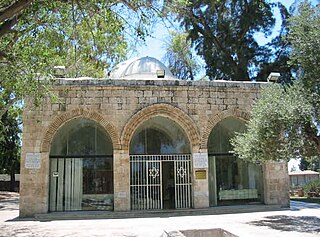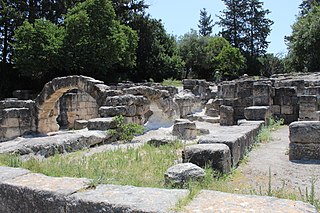Related Research Articles
Judah ha-Nasi or Judah I, known simply as Rebbi or Rabbi, was a second-century rabbi and chief redactor and editor of the Mishnah. He lived from approximately 135 to 217 CE. He was a key leader of the Jewish community in Roman-occupied Judea after the Bar Kokhba revolt.

The Sanhedrin was a legislative and judicial assembly of either 23 or 71 elders, existing at both a local and central level in the ancient Land of Israel.

Rosh Hashanah is the name of a text of Jewish law originating in the Mishnah which formed the basis of tractates in both the Babylonian Talmud and the Jerusalem Talmud of the same name. It is the eighth tractate of the order Moed. The text contains the most important rules concerning the calendar year, together with a description of the inauguration of the months, laws on the form and use of the shofar and laws related to the religious services during the Jewish holiday of Rosh Hashanah.
Semikhah is the traditional Jewish name for rabbinic ordination.
Tannaim were the rabbinic sages whose views are recorded in the Mishnah, from approximately 10–220 CE. The period of the Tannaim, also referred to as the Mishnaic period, lasted about 210 years. It came after the period of the Zugot "Pairs" and was immediately followed by the period of the Amoraim "Interpreters".
Capital punishment in traditional Jewish law has been defined in Codes of Jewish law dating back to medieval times, based on a system of oral laws contained in the Babylonian and Jerusalem Talmud, the primary source being the Hebrew Bible. In traditional Jewish law there are four types of capital punishment: a) stoning, b) burning by ingesting molten lead, c) strangling, and d) beheading, each being the punishment for specific offenses. Except in special cases where a king can issue the death penalty, capital punishment in Jewish law cannot be decreed upon a person unless there were a minimum of twenty-three judges (Sanhedrin) adjudicating in that person's trial who, by a majority vote, gave the death sentence, and where there had been at least two competent witnesses who testified before the court that they had seen the litigant commit the offense. Even so, capital punishment does not begin in Jewish law until the court adjudicating in this case had issued the death sentence from a specific place on the Temple Mount in the city of Jerusalem.
A beth din is a rabbinical court of Judaism. In ancient times, it was the building block of the legal system. Today, it is invested with legal powers in a number of religious matters both in Israel and in Jewish communities in the diaspora, where its judgments hold varying degrees of authority in matters specifically related to Jewish religious life.

Hakham is a term in Judaism, meaning a wise or skillful man; it often refers to someone who is a great Torah scholar. It can also refer to any cultured and learned person: "He who says a wise thing is called a Hakham, even if he be not a Jew." Hence, in Talmudic-Midrashic literature, wise gentiles are commonly called hakhmei ummot ha-'olam.
Rabbi Meir was a Jewish sage who lived in the time of the Mishnah. He was one of the Tannaim of the fourth generation (139-163). He is the third most frequently mentioned sage in the Mishnah and is mentioned over 3,000 times in the Babylonian Talmud. His wife Bruriah is one of the few women cited in the Gemara.
The Zugot, also called Zugoth or Zugos in the Ashkenazi pronunciation, refers both to the two hundred year period during the later Second Temple period, in which the spiritual leadership of the Jews was in the hands of five successions of "pairs" of religious teachers, and to each of these pairs themselves.

Rabban Gamaliel II was a rabbi from the second generation of tannaim. He was the first person to lead the Sanhedrin as nasi after the fall of the Second Temple in 70 CE.
Nachman Kahana is an Israeli rabbi.
Eleazar ben Azariah was a 1st-century CE Jewish tanna, i.e. Mishnaic sage. He was of the second generation and a junior contemporary of Gamaliel II, Eliezer b. Hyrcanus, Joshua b. Hananiah, and Akiva.
Joshua ben Hananiah, also known as Rabbi Yehoshua, was a leading tanna of the first half-century following the destruction of the Second Temple. He is the seventh-most-frequently mentioned sage in the Mishnah.

Beit She'arim necropolis is an extensive necropolis of rock-cut tombs near the remains of the ancient Jewish town of Beit She'arim. In early modern times the site was the Arab village of Sheikh Bureik; it was depopulated in the 1920s as a result of the Sursock Purchases, and identified as Beit She'arim in 1936 by historical geographer Samuel Klein.

Beit She'arim, also Besara, was a Jewish village located in the southwestern hills of the Lower Galilee, during the Roman period, from the 1st century BCE to the 3rd century CE. At one point, it served as the seat of the Sanhedrin, the Jewish judicial and religious council.
The House of Hillel and House of Shammai were, among Jewish scholars, two schools of thought during the period of tannaim, named after the sages Hillel and Shammai who founded them. These two schools had vigorous debates on matters of ritual practice, ethics, and theology which were critical for the shaping of the Oral Law and Judaism as it is today.
In Judaism, the priestly court was a court of Jewish law, composed of priests descended from Aaron, which operated at the Temple in Jerusalem and oversaw matters related to the priesthood and Temple rituals.
The Eretz Israel Yeshiva or The Land of the Zvi Yeshiva was the chief Jewish talmudical academy and central legalistic body of the Jewish community in the Land of Israel during the middle of the ninth century, or even earlier, until its demise in the 11th century. During its existence, it competed with the Babylonian Gaonate for the support of the growing diasporic communities. The Egyptian and German Jews particularly regarded the Eretz Israel geonim as their spiritual leaders. The history of the gaonate was revealed in documents discovered in the Cairo Genizah in 1896. Sparse information is available on the Eretz Yisrael geonim before the middle of the ninth century. The extant material consists essentially of a list in Seder Olam Zuta relating all the geonim to Mar Zutra.
References
- ↑ Yaakov Yosef Reinman (2002). Medrash Rabba HaMeVoAr. ISBN 1583306102.
- ↑ Rabbi Aryeh Kaplan (9 May 2009). "The Jewish Court System".
- ↑
 One or more of the preceding sentences incorporates text from a publication now in the public domain : Singer, Isidore; et al., eds. (1901–1906). "BET DIN". The Jewish Encyclopedia . New York: Funk & Wagnalls. Retrieved 2012-03-15.
One or more of the preceding sentences incorporates text from a publication now in the public domain : Singer, Isidore; et al., eds. (1901–1906). "BET DIN". The Jewish Encyclopedia . New York: Funk & Wagnalls. Retrieved 2012-03-15. - ↑ Yerushalmi Berachot ch.4 halacha 1
- ↑ Bavli Berachot 27b
- ↑ "What is a Beit Din".
- ↑ For cRc, R'Schwartz is #1 as Rosh, whereas for Beth Din of America, he is #1 as ABD: "Beth Din Zedek Ecclesiastical Judicature of the Chicago Rabbinical Council".
- ↑ Here, #2 at cRc is #3: "Beth Din of America". 27 July 2015.
founded in 1960 by the Rabbinical Council of America
- ↑ "About the London Beth Din" . Retrieved November 19, 2020.
- ↑ "An Insight into 'Chalak Beit Yosef' by Dayan Y. Y. Lichtenstein, Rosh Beth Din, Federation of Synagogues". HaMaor. September 2009.